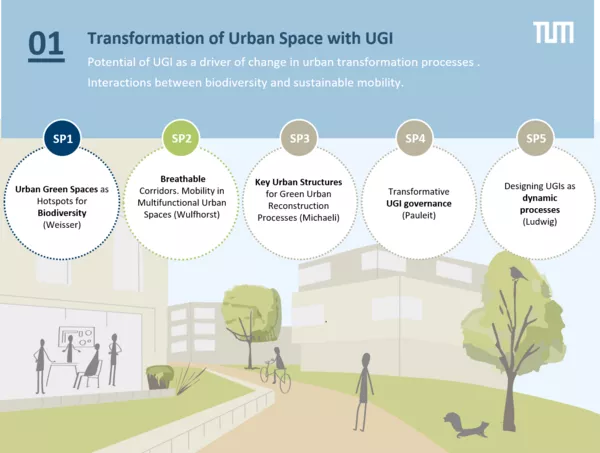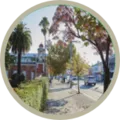Research Cluster 1: Transformation of Urban Space with UGI (Head: Mark Michaeli)

The significance of urban environments for biodiversity is now widely recognized and integrative ways to retain and enhance biodiversity within cities are sought. However, many urban residents live in districts where only a few plant and animal species occur, and this makes people increasingly separated from nature in their daily life.
UGI provides opportunities where city dwellers can experience nature, and such experience also determines how humans perceive and value it. Moreover, biodiversity underlies many ESS demanded by humans, including direct effects on well-being and health. Therefore, urban ecological reconstruction to enhance biodiversity is wanted, particularly if it comes along with the rising quality of urban life, synergies with daily activities, and the related potential for sustainable urban mobility, such as walking and cycling.
Unfortunately, urban nature and UGI have been neglected as potential drivers of change in urban planning so far despite ambitious sustainability goals laid down in strategic urban development frameworks, and in the practice of urban transformation, the potential of UGI is far from being sufficiently tapped. This is often explained with lock-in effects caused by the self-stabilizing forces of the existing urban structures and their operational framework.
Thus, sustainability transition relies on socio-technical regime transformation, mirroring all three key dimensions of SET's. A systems analysis of the governance processes is needed to overcome the barriers to integrated planning and implementation of multifunctional UGI. Case-study research has revealed complex combinations of culture-, structure- and practice-led agencies as key success factors of long-term transformation.
Scenario research has explored the plausibility of promoting or prioritizing particular avenues (e.g., political vs. market-driven approach) in facilitating transformation and application of new solutions. We seek to augment systemic knowledge in the field by complementing the multi-disciplinary approach to SET transitions by shedding light on the nature of solutions to implement UGI with the three strategies of operationalization, substitution, and integration. Characteristics of solutions as well as processes of deployment and operation of UGI, including relevant governance modes and actor networks are scrutinized against the backdrop of contemporary practice in urban transformation projects.
RC 1 aims to significantly enhance the process of transformation of the existing urban fabric and its elements towards a multifunctional UGI as a valuable resource in terms of biodiversity, sustainable urban mobility and reconstruction. The strategy of green-gray Integration is emphasized by the first two subprojects:
SP1 (Biodiversity) will study the potential of UGI for creating continuous and coherent elements of high value for biodiversity within the urban built fabric. Today, the majority of urban transformation projects focus on the element, not the network scale, thus the possibility for immediate intervention is often limited on large-scale infrastructure projects coming along e.g., with a substantial change of street layout, transportation technology and mobility behavior. Therefore, SP1 is closely interacting with SP2 (Mobility) to enhance the ecological functionality of the smart integration of UGI into the reconstruction of mobility spaces, and reciprocally upgrading these spaces as the spinal network of UGI. Ensuing questions for UGI Operationalization are in the focus of SP3 (Reconstruction) and SP4 (Governance): SP3 (Reconstruction) sheds light on the subsequent structural properties of the urban elements and networks and draws links to typical urban renewal and development projects and their qualification potential as catalysts of UGI implementation. It is expected, that this process can be facilitated with better knowledge of transformation regimes, which is systematically examined in SP4 (Governance). Finally, SP5 (Design) complements RC1 with the consideration of dynamic processes in UGI design, with links to SP1 and other research clusters (SP6 (Energy), SP7 (Microclimate), and SP8 (Urban Trees)). The novelty of the approach lies in the entanglement of structure and process, highlighting urban reconstruction and the transformative potential of UGI. The results of RC1 at different spatial scales will be considered as input for a common systems model.


SP2:Mobility
PI: Prof. Dr.-Ing Gebhard Wulfhorst

SP3: Urban Reconstruction Processes
PI: Prof. Dipl. Arch ETH Mark Michaeli

SP4: Governance
PI: Prof. Dr.-Ing. Stephan Pauleit

SP5: Designing UGI
PI: Prof. Dr. Ferdinand Luwig